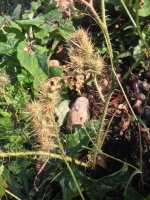Okay pics... upon closer inspection I have found several species, or however you might label them.
View attachment 340798 View attachment 340799 View attachment 340800 View attachment 340801
The most prevalent is the first one and they are normally 18in to 36in. and notice that they are mostly dead some still kicking though... we have had a couple near freezing nights and I am guessing that the cold is doing them in. Easy to pull but I suppose too late. Did spend a couple hours this afternoon wasting my time with them.
The second pic I only found one of but very unusual. I showed the wife and asked her if we should keep it and she said, WHAT?.
The third pic is of the biggest upto 4ft tall but not too many of them.
The fourth is a low growing type and I have left them alone for now. Just no fun to pull by hand. They are intermixed with a couple blackberry varieties.
. #2 appears to be bull thistle, which is a biennial, and much easier to control, as it does not regenerate through its roots. Sorry to say, #3 also looks like canada thistle, and number four is also bull thistle. Bull thistle is easily controlled in small areas by beheading. The Canada thistle is going to be your biggest challenge. It has been there forever, hidden in the black berries. The root system is massive. http://www.btny.purdue.edu/pubs/ws/canadathistle/roots.jpg Somewhere I read the average infestation laid flat would cover ten square miles.
